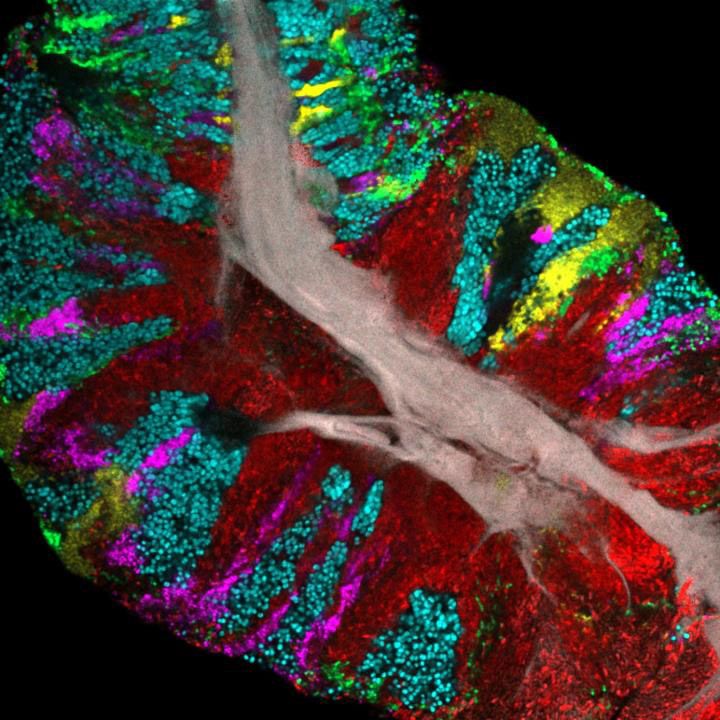Research Quick Pics
Ever used a tongue scraper in your oral hygiene routine? The image above shows what might come off—an array of tightly layered microbes called a biofilm. In an NIDCR-funded study, scientists used a new technique to visualize fluorescently labeled bacteria in intact biofilms scraped from the tongues of 21 healthy human volunteers. “No one before has been able to look at the biofilm on the tongue in a way that distinguishes all the different bacteria, so that we can see how they arrange themselves,” says senior author Gary Borisy, PhD, of the Forsyth Institute and the Harvard School of Dental Medicine. The findings were published on March 24, 2020, in Cell Reports.
In the image above, each color represents a different type of bacterium. Human tongue tissue (gray) forms a central core from which the microbial community grows outward, as indicated by the clusters and stripes.
Of the bacterial types shown to be prevalent on the human tongue, three of note—Actinomyces (red), Rothia (cyan), and Streptococcus (green)—were present in all 21 participants in the study. The prominence of these three groups suggests they may be important to maintaining oral and overall health. For example, Actinomyces and Rothia on the tongue are thought to help convert naturally occurring chemical compounds found in certain foods—called nitrates—into forms the body can use for basic functions.
“We think that learning who is next to who will help us understand how these communities work,” says co-author Jessica Mark Welch, PhD, a microbial ecologist at the Marine Biological Laboratory in Woods Hole, Massachusetts. Such efforts can help scientists better define microbes’ roles in conditions like gum disease and tooth decay and could help identify microbial targets for treating diseases and maintaining health in the mouth and beyond.
Related Links
- Technique Reveals Organization of Tongue Bacteria
- Nanoparticle Robots Sweep Away Biofilms
- Mouth Microbes
- Bacteria that Glide with the Greatest of Ease
- Tooth Decay
- Periodontal (Gum) Disease
Reference
Spatial Ecology of the Human Tongue Dorsum Microbiome. Wilbert SA, Mark Welch JL, Borisy GG. Cell Rep. 2020 Mar 24;30(12):4003-4015.e3. doi: 10.1016/j.celrep.2020.02.097. PMID: 32209464.
Attention Editors
Reprint this article in your own publication or post to your website. NIDCR News articles are not copyrighted. Please acknowledge NIH's National Institute of Dental and Craniofacial Research as the source.
Subscribe to NIDCR Science News
Receive monthly email updates about NIDCR-supported research advance by subscribing to NIDCR Science News.


